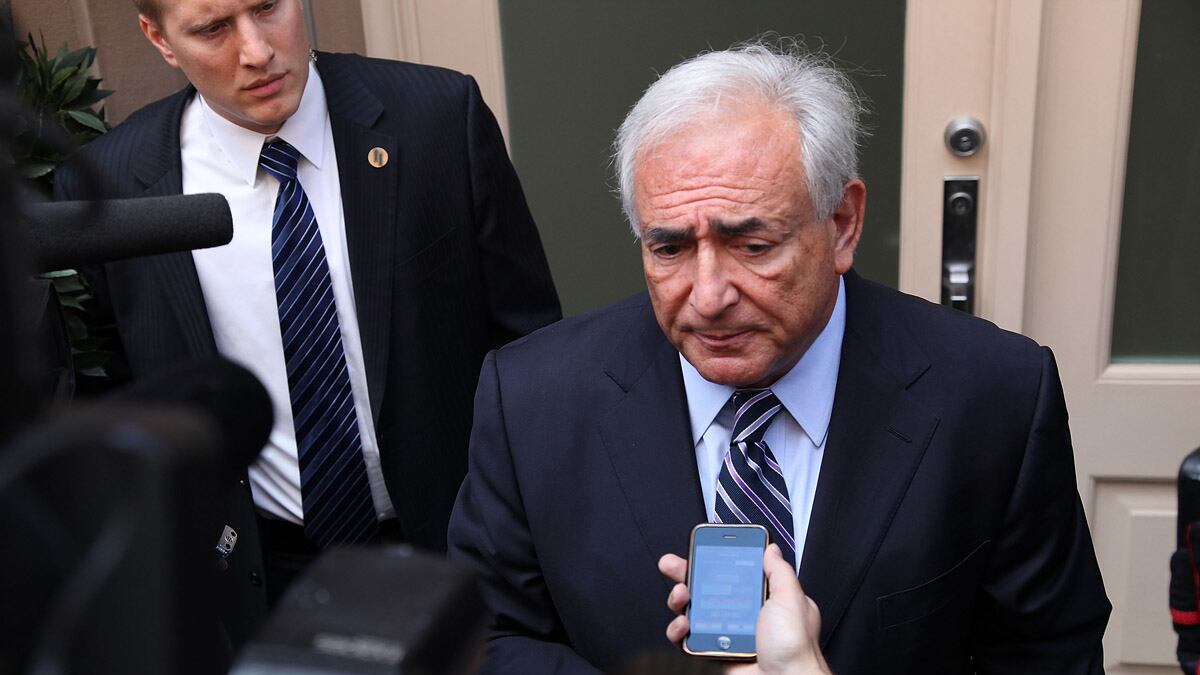The problem with conspiracy theories is that the people who concoct them like to sum up zeroes. They list the things we don’t know about a case, or that they claim we don’t know, and then they suggest the missing pieces add up to a conspiracy. And while their writing may be coy and careful, the headlines they make usually are not.
So it is with Edward Jay Epstein’s piece in the current New York Review of Books about the case of Dominique Strauss-Kahn. Was DSK the victim of a conspiracy by his main political rival, French President Nicolas Sarkozy? Epstein doesn’t quite say that. But many headlines and countless tweets based on his piece certainly give that impression.
Now let me put my cards on the table here. I generally hate conspiracy theories because so many of them are so fundamentally dishonest. They not only raise questions where there are some, they raise them when there are none. They insinuate “new” facts by ignoring known facts. And as often as not they’re concocted to shift blame away from the people who bear part or all of the responsibility for some terrible human tragedy.
The endless conspiracy theories around the death of Princess Diana in 1997 are a case in point. Hotel and department-store magnate Mohammed el-Fayed, whose son was Diana’s fling that summer and died with her in a car crash in Paris, used all his fortune and connections to try to prove that the British government plotted to do Diana in.

But of course el-Fayed would. Everybody who was involved with Diana’s death—including the drunk driver of the limousine and the ineffectual bodyguards—was either employed by el-Fayed or related to him.
In Epstein’s version of the DSK case, which reads as if it were dictated by DSK’s attorneys, the actual victim—the woman he allegedly attacked—is given scant attention. She has related her version of events to police and to Newsweek in an exclusive interview. Strauss-Kahn has never given his to the cops, the courts, or the press. So let him come clean about what happened between them, if he can.
In May, you will recall, Strauss-Kahn was accused by an African-immigrant chambermaid, 32-year-old Nafissatou Diallo, of sexually assaulting and attempting to rape her when she went to make up his suite at the Sofitel Hotel in midtown Manhattan. There were quantities of physical evidence rarely seen in such investigations: credible outcry witnesses and key-card records, conclusive DNA in sperm mixed with saliva, and a victim, Diallo, who told her story to police again and again with only the slightest discrepancies in her account. But the Manhattan district attorney eventually dropped all charges because prosecutors concluded the illiterate Diallo, with a long record of lying on official documents and a few low-life friends in the African immigrant community, wouldn’t be good on the stand. She has lodged a civil suit against DSK in the United States that will be years going through the courts.
Unfortunately for Strauss-Kahn, even when the criminal case was closed it opened up the can of very slimy worms that was his not-so-private life. His career as the head of the International Monetary Fund ended. So did his hitherto plausible hopes of becoming the next president of France. Suddenly Sarkozy’s most dangerous rival was out of the running for next year’s presidential elections. And for conspiracy theorists, effect always implies cause. But Epstein can’t quite nail it.
In Epstein’s report the most intriguing revelation, if that is what it is, concerns what Strauss-Kahn called his “IMF BlackBerry.” Epstein claims that according to multiple (anonymous) sources, DSK had received a text message from “a woman friend temporarily working as a researcher at the Paris offices of the UMP, Sarkozy’s center-right political party.” This woman friend said a private text message that Strauss-Kahn had sent his wife, the millionaire heiress and journalistic celebrity Anne Sinclair, had been read by people at the Sarkozy party HQ. (Apparently the woman friend did not worry about sending him a text message herself.) The party leadership and top Sarkozy aides have roundly denied and denounced the insinuations in the Epstein report. But at little after 10 on that fateful morning of May 14, DSK called Sinclair and said there was a problem, and he wanted some of his team to look at his BlackBerry and his iPad when he got back to Paris the following day to see if they’d been hacked. In the meantime, he was due to meet his daughter for an early lunch. And at some point, this man juggling a bag full of phones, according to Epstein, lost the damn IMF BlackBerry.
Epstein does not mention the blonde woman who was seen with Strauss-Kahn the evening before, and who left the hotel before dawn, according to surveillance tapes obtained by the police. (Hard to keep track of all those women friends, I guess.) Epstein does not tell us what Strauss-Kahn was doing in New York City in the first place, although we know he wasn’t on official business.
And when Epstein gets to the actual encounter between Diallo and DSK, an incident that key records and phone records suggest lasted less than seven minutes, Epstein passes it by in a single paragraph. He notes that the New York prosecutor had concluded there was a “hurried sexual encounter.” Strauss-Kahn had been in the shower and—well, we don’t know what he says happened.
What Diallo said in her interview with Newsweek last July was that he was naked and attacked her with no warning or provocation, eventually forcing her back into the corridor of the suite. (Why not the bedroom if, as DSK’s lawyers “suggest,” it was a consensual encounter?) She claimed he groped her crotch, pulling at her pantyhose, but the barrier was impregnable. As the prosecutors’ report noted, Diallo was wearing two pairs of pantyhose as well as panties: not exactly normal attire for a woman looking for casual or pecuniary sex.
Perhaps DSK was struggling with this modern equivalent of a chastity belt because he thought the IMF BlackBerry was in there somewhere. (Of course I am being ironic, but one of the most devastating cartoons that has come out about the case in France shows DSK looking down into his own underwear. “Strauss-Kahn the victim of a plot?” reads the title. “WHO put that in my pants?” DSK is asking.)
As my colleague John Solomon noted in an article published Sunday, the supposed discrepancies in Diallo’s testimony that are cited by Epstein were really not discrepancies at all. Why did she go back and forth to another room down the hall? Because she was waiting for the people there to check out, as they said they were about to do, and most of the other rooms on the floor had "do not disturb" lights on. The trip she made there after the incident was to pick up her cleaning supplies, trying, as people do when they are in shock, to resume her routine.
Epstein also makes much of two men connected with Sofitel security later giving each other a high five and exulting in what he describes as “an extraordinary dance of celebration,” even though Epstein goes on to admit it is “not clear” what they were celebrating. And so on.
But let’s step back for a second here. Let’s say for the sake of argument there was a plot hatched to discredit DSK. Would this be it? Could it be?
Given the timing and the physical evidence that is undeniable, the plot would have to depend on this guy being reliably inclined to thrust his penis into the mouth of any woman who gave him the slightest chance. This one he had known for less than seven minutes. And if someone was plotting this, Diallo was a curious choice as a seductress. Her face is scarred from some skin condition. And while she’s not fat, she’s certainly heavy-set. Indeed, she says she was terrified of losing her job as he attacked her like a madman, and she was especially worried that if she hurt him that would be the end of her employment. She says she didn’t know who this crazy, gray-haired, stark-naked man was, but she knew he was in one of the hotel’s most expensive suites. As an illiterate immigrant, she would have had nowhere to turn if he denounced her to the management. In the end, wrestled to the ground in the hallway, by her account, she decided to let DSK get off so she could just get out of there.
If that’s not what happened, we don’t need Edward Jay Epstein to speculate about what happened. Unlike so many other figures in convoluted conspiracy theories—Jack Kennedy and Lee Harvey Oswald, for instance, or Princess Diana and Dodie el-Fayed—Dominique Strauss-Kahn is still alive and well and perfectly able to tell us exactly what happened in the Sofitel. If only he would.




